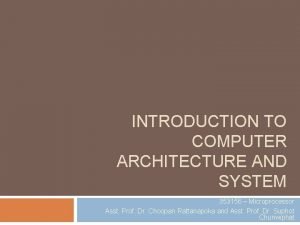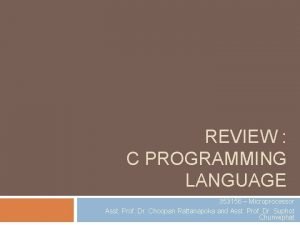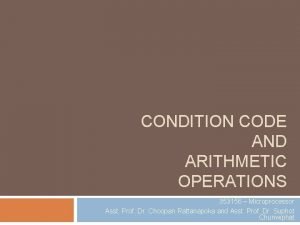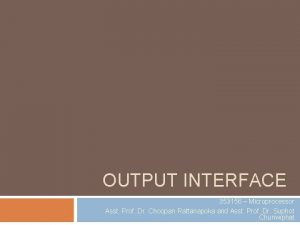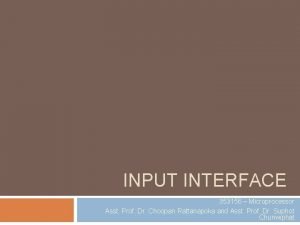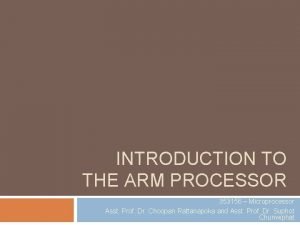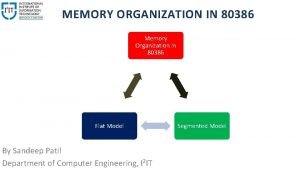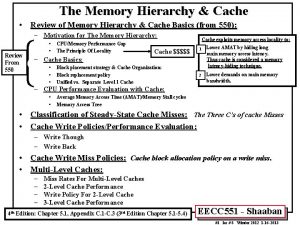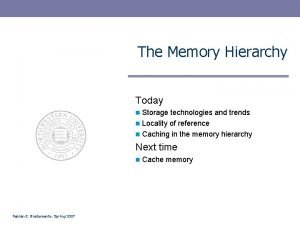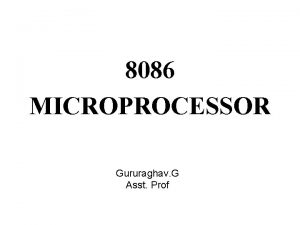MEMORY HIERARCHY 353156 Microprocessor Asst Prof Dr Choopan












- Slides: 12

MEMORY HIERARCHY 353156 – Microprocessor Asst. Prof. Dr. Choopan Rattanapoka and Asst. Prof. Dr. Suphot Chunwiphat

Two 7 -Segments Display Last week, we control a 7 -segment How about two 7 -segments if you want to display a number “ 53” on two 7 -segment Suppose we define a local variable � unsigned We can get the most significant digit (MSD) by � unsigned int number = 53; int MSD = number / 10; We can get the least significant digit (LSD) by � unsigned int LSD = number % 10; OR � unsigned int LSD = (number – (MSD * 10))

Exercise 1 Suppose X = 1456; � 6 as the first digit � 5 as the second digit � 4 as the third digit � 1 as the fourth digit How to write a program to store the first digit, the second digit, the third digit and the fourth digit of X in variable A, B, C, and D respectively ?

Memory Hierarchy ALU Registers Load/Store CPU RAM We have learnt that CPU need to load instructions from RAM to register (Fetch) Then, CPU decodes the instruction (Decode) Then Execute the instruction (Execute) However, transfer data between CPU and RAM is slow comparing to CPU processing speed

Cache Level 1 The solution to fix the slow data transfer rate between CPU and RAM, The CPU manufacturer put a high speed memory called “cache” inside in CPU chip. Thus, the set of instructions will be loaded from RAM to cache and then CPU can load instructions from cache Cache L 1 run at CPU clock speed, but it’s quite small ALU Registers � Intel core-i 7 has 32 k. B of instruction cache 32 k. B of data cache Load/Store Cache L 1 CPU RAM

Cache Level 2 Only cache L 1 is not enough to improve PC performance that much. In the past, mainboard manufacturers put a faster memory as a buffer between CPU and RAM. We call it “cache level 2” (cache L 2) As time goes by, The CPU manufacturers can make circuits inside CPU smaller and smaller. Thus, there is more space left on the CPU die. CPU manufacturers put cache level 2 inside CPU. (Normally cache L 2 size is around 1 MB to 6 MB) ALU Registers Cache L 1 Cache L 2 RAM CPU ALU Registers Cache L 1 Cache L 2 CPU RAM

CPU Core Since CPU technology develops very fast. The circuits inside CPU becomes smaller and smaller. The CPU manufacturers decides to fill up the die with multiple ALU, cache, and registers (core) In theory, CPU can do more than 1 instruction at a time Core ALU Registers Cache L 1 Cache L 2 CPU

CPU : 1 core VS 2 cores ALU Core Registers ALU Core ALU Registers Cache L 1 Cache L 2 CPU

Cache Level 3 CPU core 2 family (core 2 -duo, core 2 -quad) has only cache L 2 However in core-i family (core-i 3, core-i 5, core-i 7), Intel put cache L 3 in CPU. This cache is shared for all the cores in chip Cache L 3 size is around 8 MB

Virtual Memory Remind you that programs need to be loaded to RAM. CPU can’t read instruction or data from harddisk directly. How about some software such as game ? � For example: Game size is 8 GB � But your PC has RAM only 4 GB (can you play this game? ) We need to extend RAM size to fit software size � Operating System (OS) use some part of harddisk to act as a RAM extension, we call it “Virtual Memory” � Normally Virtual Memory size is about 2 – 2. 5 times of RAM size

Memory Conclusion (1) RAM Harddisk Virtual Memory

Memory Conclusion (2) Central Processor Unit (CPU) Increasing Distance from CPU, Decreasing cost / MB “Upper” Levels in memory hierarchy “Lower” Cache L 1 Cache L 2 Cache L 3 RAM Virtual Memory Size of memory at each level


